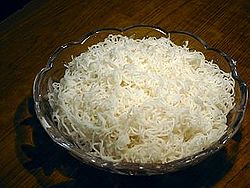Sevai
 Freshly extruded Sevai | |
| Alternative names | Shyavige |
|---|---|
| Type | Rice noodle/rice vermicelli |
| Place of origin | India |
| Region or state | Tamil Nadu and Karnataka |
| Main ingredients | Rice |
| Variations | Santhakai |
Sevai or shyavige or santhakai is a type of rice vermicelli popular in Southern India, particularly Tamil Nadu (Kongunadu region) and Karnataka. Santhakai is made out of other food grains like wheat, ragi, etc. also are increasingly becoming popular.
Sevai is distinctly different from its cousin idiappam in the sense of input material, making process, and post-extrusion recipes. Sevai is popular as a breakfast or dinner food and is easily digestible as it can be made with less or no oil, and it is steamed.
Making
Sevai is mostly made fresh starting from rice grains. It is also prepared from a dried sevai packs (or rice sticks) like the instant ones in the Asian grocery stores. Traditionally, making of sevai at home consists of the following steps (with minor variations based on location and family customs):
- Soaking of parboiled rice in cold water for about 3 hours
- Grinding of soaked rice using a wet grinder into a fine paste
- Making of dumplings from the rice paste and steaming the chunks (at least three variations are known in this step as follows)
- Sautéeing the paste into dough, make dumplings (also called kozhukkottais, steam the same on an idli vessel
- pour the paste into moulds of the idli vessel and steam the same
- Sautéeing the paste into dough, make dumplings, drop the same into boiling water and through cook
- Sautéeing the paste into dough, make medium-sized balls of the dough and pass it through "sevai press" into idli plates and then steam it.
- Pressing of cooked dumplings into fine strands using a type of Sevai press
Composition
Homemade sevai is often made from 100% rice (in addition to water and salt) whereas dry rice sticks may often have some additives like tapioca, corn starch, etc. Instant rice noodles have other additives like Wheat gluten, Guar gum, edible starch, etc. In Southern parts of Karnataka, shyaavige is made of different grains with different consistencies. When made with ragi or millet the vermicelli is fatter, whereas when made with rice or wheat the strands are thinner.
Other terms
Sevai is called santhakai in the western parts of Tamil Nadu; it is called shavige in Kannada. People also loosely use the terms idiappam and semiya (vermicelli) for Sevai, even though these foods are different from Sevai in several aspects. In Tamil, these are written சந்தகை, சந்தவம், சந்தவை.
Foods prepared with Sevai

Shyavige can be made into a breakfast dish in Karnataka when cooked with vegetables and tempered with spices with a dash of lemon juice or a sweet dish called Payasam when cooked in milk with cardamom or other select spices and sugar. In the Malnad region of Karnataka rice shyaavige may be served with chicken curry. The other variants made with ragi or Jowar are served plain with accompaniments like sweetened coconut milk and various edible powders that include powdered chickpea and sesame. In Tamil Nadu santhakai is often flavoured with lemon, tamarind, tomato, coconut, curd etc. and is usually eaten warm. Popular accompaniments for plain sevai are sweetened coconut milk, banana sugar and ghee, more-kuzhambu, several vegetable kormas and mutton, chicken, or fish korma.



